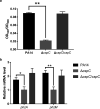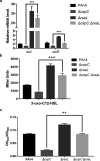Acetylation of CspC Controls the Las Quorum-Sensing System through Translational Regulation of rsaL in Pseudomonas aeruginosa
- PMID: 35467416
- PMCID: PMC9239060
- DOI: 10.1128/mbio.00547-22
Acetylation of CspC Controls the Las Quorum-Sensing System through Translational Regulation of rsaL in Pseudomonas aeruginosa
Abstract
Pseudomonas aeruginosa is a ubiquitous pathogenic bacterium that can adapt to a variety environments. The ability to effectively sense and respond to host local nutrients is critical for the infection of P. aeruginosa. However, the mechanisms employed by the bacterium to respond to nutrients remain to be explored. CspA family proteins are RNA binding proteins that are involved in gene regulation. We previously demonstrated that the P. aeruginosa CspA family protein CspC regulates the type III secretion system in response to temperature shift. In this study, we found that CspC regulates the quorum-sensing (QS) systems by repressing the translation of a QS negative regulatory gene, rsaL. Through RNA immunoprecipitation coupled with real-time quantitative reverse transcription-PCR (RIP-qRT-PCR) and electrophoretic mobility shift assays (EMSAs), we found that CspC binds to the 5' untranslated region of the rsaL mRNA. Unlike glucose, itaconate (a metabolite generated by macrophages during infection) reduces the acetylation of CspC, which increases the affinity between CspC and the rsaL mRNA, leading to upregulation of the QS systems. Our results revealed a novel regulatory mechanism of the QS systems in response to a host-generated metabolite. IMPORTANCE Bacterial infectious diseases impose a severe threat to human health. The ability to orchestrate virulence determinant in response to the host environment is critical for the pathogenesis of bacterial pathogens. Pseudomonas aeruginosa is a leading pathogen that causes various infections in humans. In P. aeruginosa, the quorum-sensing (QS) systems play an important role in regulating the production of virulence factors. In this study, we find that a small RNA binding protein, CspC, regulates the QS systems by repressing the expression of a QS negative regulator. We further demonstrate that CspC is acetylated in response to a host-derived metabolite, itaconate, which alters the function of CspC in regulating the QS system. The importance of this work is in elucidation of a novel regulatory pathway that regulates virulence determinants in P. aeruginosa in response to a host signal.
Keywords: CspC; Pseudomonas aeruginosa; acetylation; itaconate; quorum sensing.
Conflict of interest statement
The authors declare no conflict of interest.
Figures







Similar articles
-
Identification of the Pseudomonas aeruginosa AgtR-CspC-RsaL pathway that controls Las quorum sensing in response to metabolic perturbation and Staphylococcus aureus.PLoS Pathog. 2025 Apr 8;21(4):e1013054. doi: 10.1371/journal.ppat.1013054. eCollection 2025 Apr. PLoS Pathog. 2025. PMID: 40198682 Free PMC article.
-
Acetylation of the CspA family protein CspC controls the type III secretion system through translational regulation of exsA in Pseudomonas aeruginosa.Nucleic Acids Res. 2021 Jul 9;49(12):6756-6770. doi: 10.1093/nar/gkab506. Nucleic Acids Res. 2021. PMID: 34139014 Free PMC article.
-
Affecting Pseudomonas aeruginosa phenotypic plasticity by quorum sensing dysregulation hampers pathogenicity in murine chronic lung infection.PLoS One. 2014 Nov 24;9(11):e112105. doi: 10.1371/journal.pone.0112105. eCollection 2014. PLoS One. 2014. PMID: 25420086 Free PMC article.
-
Mechanisms of the Quorum Sensing Systems of Pseudomonas aeruginosa: Host and Bacteria.Curr Med Chem. 2024;31(35):5755-5767. doi: 10.2174/0929867331666230821110440. Curr Med Chem. 2024. PMID: 37605403 Review.
-
Revisiting the virulence hallmarks of Pseudomonas aeruginosa: a chronicle through the perspective of quorum sensing.Environ Microbiol. 2022 Jun;24(6):2630-2656. doi: 10.1111/1462-2920.15784. Epub 2021 Oct 6. Environ Microbiol. 2022. PMID: 34559444 Review.
Cited by
-
The transcriptional regulators of virulence for Pseudomonas aeruginosa: Therapeutic opportunity and preventive potential of its clinical infections.Genes Dis. 2022 Oct 1;10(5):2049-2063. doi: 10.1016/j.gendis.2022.09.009. eCollection 2023 Sep. Genes Dis. 2022. PMID: 37492705 Free PMC article. Review.
-
Lysine acetylation regulates the AT-rich DNA possession ability of H-NS.Nucleic Acids Res. 2024 Feb 28;52(4):1645-1660. doi: 10.1093/nar/gkad1172. Nucleic Acids Res. 2024. PMID: 38059366 Free PMC article.
-
Identification of the Pseudomonas aeruginosa AgtR-CspC-RsaL pathway that controls Las quorum sensing in response to metabolic perturbation and Staphylococcus aureus.PLoS Pathog. 2025 Apr 8;21(4):e1013054. doi: 10.1371/journal.ppat.1013054. eCollection 2025 Apr. PLoS Pathog. 2025. PMID: 40198682 Free PMC article.
-
RsaL is a self-regulatory switch that controls alternative biosynthesis of two AHL-type quorum sensing signals in Pseudomonas aeruginosa PA1201.mLife. 2024 Mar 18;3(1):74-86. doi: 10.1002/mlf2.12113. eCollection 2024 Mar. mLife. 2024. PMID: 38827515 Free PMC article.
References
-
- Garcia-Nunez M, Marti S, Puig C, Perez-Brocal V, Millares L, Santos S, Ardanuy C, Moya A, Linares J, Monso E. 2017. Bronchial microbiome, PA biofilm-forming capacity and exacerbation in severe COPD patients colonized by P aeruginosa. Future Microbiol 12:379–392. doi:10.2217/fmb-2016-0127. - DOI - PubMed
Publication types
MeSH terms
Substances
LinkOut - more resources
Full Text Sources
Miscellaneous

